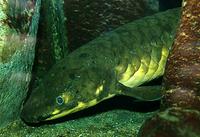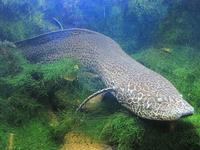Lobe-finned fishes (Sarcopterygii) fish profiles
Lobe-finned fishes (Sarcopterygii) fish profile and information / pictures of Lobe-finned fishes - Sarcopterygii
Lobe-finned fish information and info on the Sarcopterygii also known as Lobe-finned fishes Early Lobe-finned fish are bony fish with fleshy, lobed, paired fins, which are joined to the body by a single bone. The fins of crossopterygians differ from those of all other fish in that each is borne on a fleshy, lobelike, scaly stalk extending from the body. Pectoral and pelvic fins have articulations resembling those of tetrapod limbs. These fins evolved into legs of the first tetrapod land vertebrates, amphibians. They also possess two dorsal fins with separate bases, as opposed to the single dorsal fin of ray-finned fish. The braincase of Lobe-finned fish primitively has a hinge line, but this is lost in tetrapods and lungfish. Many early Lobe-finned fish have a symmetrical tail. All Lobe-finned fish possess teeth covered with true enamel. Taxonomists who subscribe to the cladistic approach include the grouping Tetrapoda within this group, which in turn consists of all species of four-limbed vertebrates. The fin-limbs of Lobe-finned fish such as the coelacanths show a strong similarity to the expected ancestral form of tetrapod limbs. The crossopterygians apparently followed two different lines of development and are accordingly separated into two subclasses, the Rhipidistia (including the Dipnoi or lungfish, and the Tetrapodomorpha which include the Tetrapoda) and the Actinistia (coelacanths).
|
Orders within this class |


